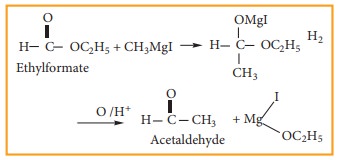Chapter: 11th Chemistry : UNIT 14 : Haloalkanes and Haloarenes
Uses of Grignard reagent
Uses of Grignard reagent
Grignard reagents are synthetically very useful compounds. These reagents are converted to various organic compounds like alcohols, carboxylic acids, aldehydes and ketones. The alkyl group being electron rich acts as a carbanion or a nucleophile. They would attack polarized molecules at a point of low electron density. The following reactions illustrate the synthetic uses of Grignard reagent.
(1) Preparation of primary alcohol
Formaldehyde reacts with Grignard reagent to give addition products which on hydrolysis yields primary alcohol.

2) Preparation of secondary alcohol
Aldehydes other than formaldehyde, react with Grignard reagent to give addition product which on hydrolysis yields secondary alcohol.

3) Preparation of Tertiary alcohol
Ketone reacts with Grignard reagent to give an addition product which on hydrolysis yields tertiary alcohols.
Example

(4) Preparation of aldehyde
Ethyl formate reacts with Grignard reagent to form aldehyde. However, with excess of Grignard reagent it forms secondary alcohol.
Example

(5) Preparation of ketone
Acid chloride reacts with Grignard reagent to form ketones. However, with excess of Grignard reagent it forms tertiary alcohol.
Example

6) Preparation of carboxylic acids
Solid carbon dioxide reacts with Grignard reagent to form addition product which on hydrolysis yields carboxylic acids.
For Example

7) Preparation of esters
Ethylchloroformate reacts with Grignard reagent to form esters.
Example

8) Preparation of higher ethers
Lower halogenated ether reacts with Grignard reagent to form higher ethers.
Example

9) Preparation of alkyl cyanide
Grignard reagent reacts with cyanogen chloride to from alkyl cyanide
Example

10) Preparation of Alkanes
Compounds like water, alcohols and amines which contain active hydrogen atom react with Grignard reagents to form alkanes.
Example

Related Topics